Personalized emails are way more powerful than one-size-fits-all messages.
They deliver 6x higher transaction rates, according to Experian. And according to Campaign Monitor, emails with personalized subject lines have a 26% higher chance of getting opened.
Every marketer right now is trying to take their email personalization to the next level. In fact, it’s the most commonly used email marketing tactic, according to the HubSpot Research Global Survey.
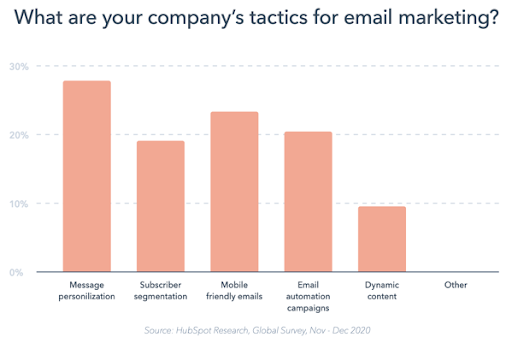
So in this article, I’ll discuss 6 personalization tips that have helped me throughout my years as a marketer. And you’ll (hopefully) be writing way better emails by the end of this article.
But first, let’s discuss what email personalization really means.
What is email personalization?
Contrary to popular belief, email personalization is a lot more than addressing your recipient by their first name.
It involves everything marketers do to make each recipient believe that the email was written only for them. This means sending out relevant content (e.g. shopping suggestions) at the right time using the right data (e.g. shopping preferences, gender, and location).
You should focus on the word relevant because that’s what makes personalization so powerful. Just think about it — we live in an age of immense digital noise. People receive tens and hundreds of marketing emails each day. Why should they open yours? Because they care about what you’re saying.
Another aspect of email personalization is “human-ness”. People don’t want to be treated like just another email address in your database. They don’t want to read run-of-the-mill, automated emails that could have been easily written by shaky AI software.
Instead, people want to be treated as complex human beings with very specific needs and preferences. This is why your emails should sound like they’re coming from another human, not a robot.
At the end of the day, the goal is to make the reader feel special, which increases the chance that they’ll respond positively to your call-to-action (CTA).
If you’re wondering how much of an effect personalization creates, it has been shown to increase revenue by a whopping 760% (according to Campaign Monitor).
Let’s see how you can personalize your marketing emails to boost your revenue.
Limit the use of your reader’s name

Using your reader’s name in your emails is a good way to personalize them. But overdoing it is a sure-fire way to sound creepy and salesy.
If using your recipient’s name is the only thing you’re doing to personalize your emails right now, make sure to show restraint.
Personally, I rarely mention my recipient’s name more than once in the body of my emails. Once you’ve conveyed to them that you know their name (and that you care about them), you can begin using “you” to address them.
One good place to use your reader’s name is the subject line (which is one of the subject line best practices). Nathan, check out this smartwatch we just launched sounds a lot better than Check out this new product.
Hire a copywriter
This might sound silly, but it works. No matter how well-timed and relevant your emails are, they’ll be ineffective if they’re not well-written.
But how does good writing personalize an email? Well, one aspect of personalizing emails is building a connection with your reader. The goal is to make them relate to you and instantly feel connected to your message.
And a professional copywriter can be very helpful in this regard. They can use the right mix of persuasion, story-telling, and personalization to increase the effectiveness of your marketing campaigns.
Of course, you’ll have to give them relevant data so they know who they’re writing to and how they can personalize your emails to the max.
Tweak the “From” line
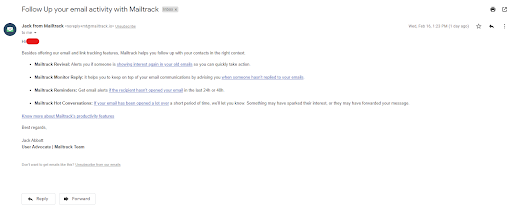
Your emails might be written by a copywriter but your audience doesn’t have to know that. One simple way to personalize emails is to make them look like they’re directly coming from an employee of your company.
You can do this by replacing your business’ name with an employee’s name in the “From” line. You can also mention your business name after a human name in the “From” line. It could say something like “James from XYZ” or “Anna from XYZ Marketing” or “Howard from XYZ Sales”.
As I already mentioned, people want to be treated as humans. So they respond to emails from a human more positively than those from a business.
Plus, modern devices make the “From” line very prominent so users can quickly identify email senders. This is why 68% of Americans base their decision to open an email on the “From” line, which means tweaking it can be an effective way to make emails more personalized.
It’s especially helpful to send emails from those employees who are dealing with a particular account. For example, if Jason is dealing with account 1, all emails sent to the address associated with account 1 should mention Jason in the “From” line.
Similarly, if Madeline is dealing with account 2, emails sent to account 2 should come from her (and not Jason).
It’s also a good idea to use a real person’s picture instead of your company logo when sending out emails. Again, the human touch makes emails more personalized. Plus, human faces are good at converting users into customers.
According to VWO, Medalia — a Brazilian art company — was able to increase website conversions by 95% by using human photos on their pages. The same effect might apply to emails.
Keep in mind that tweaking the “From” line doesn’t mean you should ignore your email signature. A well-designed email signature is a must if you want to come across as professional. Make sure it contains at least 2 pieces of contact information that your customers can use to reach you.
Leverage important dates
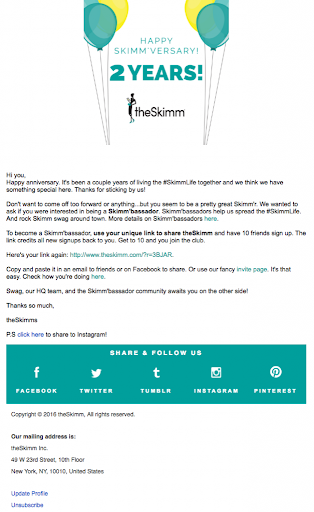
It feels good when people wish you a happy birthday (or anniversary). You can use these days to build a relationship with your customers and make them feel special. This will make them respond to your emails more positively.
Depending on your business, you can use these dates to send out product recommendations. This will make your emails relevant and timely, which is what personalization is all about.
Sometimes, you don’t even have to go salesy. A simple happy birthday email might be enough to convert a casual customer into someone who keeps coming back.
You’ll need to collect relevant data before you could do this. Using email sign-up forms to ask for important dates is a good idea. But try to keep it as short as possible, so people don’t bounce off it.
In fact, collecting the right data is the first step when it comes to email personalization. As I mentioned earlier, personalizing emails is all about delivering relevant content to each recipient. And this is impossible if you don’t know what your recipients are interested in.
So in addition to asking important dates on your sign-up forms, consider asking other industry-related questions as well.
For example, if you’re a digital marketing agency, you can ask potential clients about the size of their company and their monthly marketing budget as they sign up for your marketing newsletter.
This will allow you to segment your list and hyper-target customers, increasing email personalization and the chances of conversion.
Segment your email lists
Not every customer engages with your company in the same way. For example, some customers might buy your products for personal use, while others may use them as gifts. Similarly, some customers might be paying, while others may be using a free plan, depending on your service.
It wouldn’t make sense to send the same emails to different groups of customers. They won’t be relevant to them, which means they’ll end up getting deleted.
To avoid this, you should divide your customers into different groups according to certain data points. Customers in each group would be similar in nature, which would allow you to send them relevant emails, improving personalization and engagement.
Here’s an infographic from Lyris showing how effective segmentation is:
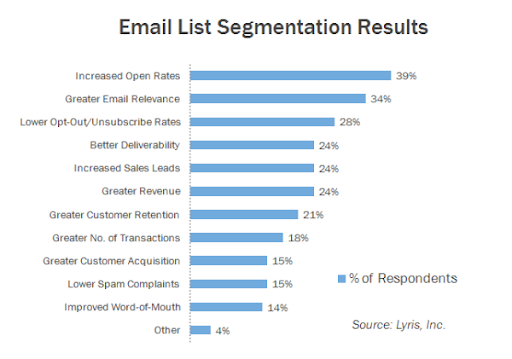
There are no fixed rules on how you should segment your list. It depends on the type of business you have and the data you’re able to collect. Common data points used to segment lists include:
- Gender. This is especially relevant in industries like clothing, make-up, and fashion accessories. You wouldn’t send lipstick recommendations to males.
- Location. This is useful when you run a location-based business like a clinic or restaurant. Location is also important for timing your emails well. If you’re targeting people from another time zone, you don’t want your emails to reach them at midnight.
You can also track the time and date your emails are read. Many email marketing tools offer this feature, and it helps you send emails when they’re most likely to be opened.
- Position. Knowing the position and decision-making power of a recipient is helpful, especially in B2B marketing. A CEO and an intern would need different types and frequencies of messaging to engage.
- Buying history. If someone has bought a table tennis racket from your store, sending out recommendations for other table tennis products is relevant to them. If someone buys a soccer ball instead, sending out soccer-related content is more relevant.
- Package type. Free and paying customers should not be sent the same emails. Emails sent to free customers are usually sales-focused, while those sent to paying customers are aimed at keeping them engaged and helping them make the best use of your product or service.
- Device type. This is often missed but it’s crucial. Desktop and mobile phones offer different email experiences, and you can leverage this to your benefit. You should pay special attention to mobile phones because they’re the most popular way customers interact with marketing content, according to Adobe.

There are many more data points that you can base your segmentation on. It’s also possible to use multiple data points for segmentation, which would allow you to create different user personas.
Again, the challenge here is to collect all this data from users without annoying them. In addition to using sign-up forms, you can also send periodic surveys to your list to know more about them.
For example, you can add a survey to your welcome sequence, asking new customers how frequently they would like to receive your emails. This can serve as another data point for segmentation.
Luckily, most email campaign tools offer segmentation features, so you won’t have to invest too much time into this.
Send out behavior-triggered emails
Behavior-triggered emails are relevant. And they’re sent at the right time, which makes them very personalized.
Examples of behavior-triggered emails include:
- Welcome emails. These are sent when someone makes a purchase from your store or signs up for your newsletter. They serve to recognize and acknowledge a customer’s actions and are important relationship-starters. Here’s an example of a welcome email:
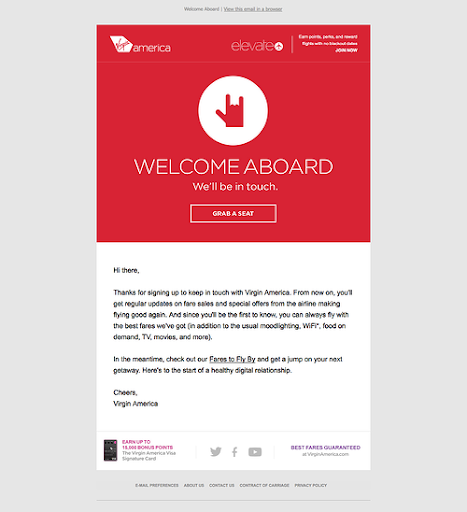
- Order confirmation emails, which are an important type of post-purchase email. They let the customers know their order has gone through. Order confirmation emails are also excellent opportunities for upselling to customers. You can recommend more products related to their purchase or send educational content about their order.
Again, these emails are relevant and customers look forward to reading them, making them excellent marketing tools.
- Progress reports. Depending on your service, sending periodic progress reports is an excellent way to engage customers. You may have received progress-related emails from your bank. It tells customers that your company is paying attention to their progress, making them feel special. Plus, progress emails are very likely to be opened, meaning they’re excellent opportunities to market other products and services.
It’s important to market subtly when sending out behavior-triggered emails — they shouldn’t sound too salesy (unless they’re a part of an abandoned cart sequence).
Now you know how to personalize emails
If I have to summarize this entire article in two words, they would be relevancy and timing. Email personalization is all about sending the right content at the right time. The goal is to make the reader feel special, which increases the chances of getting a positive response.
To personalize your emails, the first step you should take is gathering the right data. Use sign-up forms and periodic surveys to gather important data points that could be used to segment your list. These include important dates, demographic data, and buying habits.
Once you have segmentation data points, you can use these to send out relevant content at the right time. Behavior-triggered emails are also a good idea because users expect them, making them good marketing tools.
Finally, try to give your email campaign a human touch. This involves addressing readers by their name, writing good email copy, and tweaking the “From” line to establish a good connection with your recipients.
